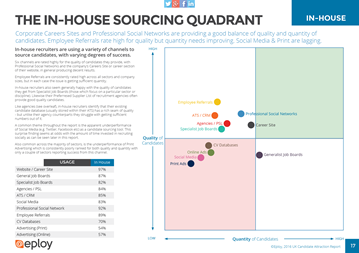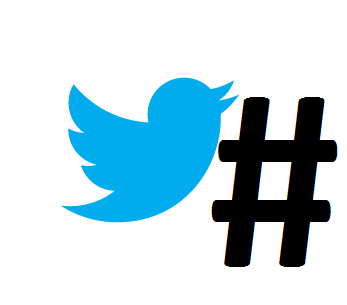Love it or loath it, social media networking has a place in connecting with candidates but can be a square peg in a round hole if you don’t know your LinkedIn from your Snapchat and what is working to attract and engage target candidates. In this first of a series of blogs we will look at Facebook, Twitter and Instagram as platforms for connecting with candidates and next time we’ll cover using LinkedIn, Google+ and Snapchat.
In the Candidate Attraction Survey 2017 we revealed the best channels for sourcing quality and quantity candidates and of all of the channels in use, social media delivered disappointing results for recruiters. It was the fifth most used channel by 64% of in-house  recruiters, used more than ATS/CRM/Talent Pool solutions, yet lagged behind every channel to find the right quality and quantity of candidates. In organisations with between 251 – 1000 employees it was as high as the second most used channel, yet again delivered the least desirable results.
recruiters, used more than ATS/CRM/Talent Pool solutions, yet lagged behind every channel to find the right quality and quantity of candidates. In organisations with between 251 – 1000 employees it was as high as the second most used channel, yet again delivered the least desirable results.
One thing we do know from the survey is that regular measurement and monitoring of activity can go some way to improving the effectiveness of social media engagement. Some of the most popular social media platforms available to us include Facebook, LinkedIn, Google+, Snapchat, Instagram and Twitter. However, the audiences they attract and the way in which they are used are all different so we’ve developed a short summary of each combined with research on social networking from Ipsos Connect who conduct a quarterly nationally representative Tech Tracker survey that measures the emerging trends and developments across technology.
First off, we know from the Ipsos Connect Tech Tracker research that 7 in 10 GB adults access social networking sites, with half using their smartphones to do so. That’s one big audience! If we breakdown the most popular social networking sites and understand the demographics of users we can glean tips for connecting and engaging candidates.
Facebook
Facebook remains the social media platform used by the most people, young and old alike. Posts you make to your Company page will appear in your ‘likers and followers’ news feed but only the first 450 or so characters appear so make your content count with a fine tuned message. In each post be sure to communicate the call to action with your network – apply here, leave a review, like this post, share this post etc. Use Facebook creatively using words, photos and video content to connect with and build your community. Facebook uses algorithms that rewards content which receives engagement. It lets your followers friends know on their newsfeed that they have engaged with your content.
On your Company Facebook page you can instantly see how your posts are doing and what followers are engaging with to focus content on getting more people interacting. Clicking on your page Insights Tab will provide reports on how many people you have reached, page views and a whole host of other metrics that you can learn from and even export in different date types and formats.
So, what is the typical demographic of a Facebook user? According the Ipsos Connect Tech Tracker survey it’s a pretty even split of Male (46%) and Female (54%) users and the age split is as follows:
15-24 - 19%
25-34 – 22%
35-44 – 18%
45-54 – 17%
55+ - 24%
The socio-economic group breakdown is:
AB – 26%
C1 – 29%
C2 – 22%
DE – 24%
There’s a pretty even spread of male/female, ages and socio groups using Facebook so this seems like a good wide ranging platform to build your community and share something great. Photos as well as employee engagement videos that really showcase the company culture in the run up to posting a key vacancy can really help to build engagement and show the human element.
Plan the timing of your posts and don’t dismiss evenings or commuting time when audiences have time to browse feeds. Be clever about your frequency of posting – you need to have regular engagement but don’t want to appear too desperate by posting content such as vacancies daily.
We haven’t even covered using Facebook for creating Ad campaigns for specific targeting or raising brand awareness which we will cover later on in the social media blog series. So in the meantime, promote your Facebook page on your other communication tools to encourage sharing and engagement - consider business cards, email signatures, website, ‘contact us’ details etc to build followers organically.
Twitter
Twitter posts are a way to share high level content with a limited character count (now 280) not only to those who follow you but by using hashtags in your post content becomes searchable across Twitter i.e. #interviewrules #recruitingtips etc. This could then start a conversation on a particular topic and engage a wider audience interested in a specific topic. Here is a beginner’s guide to the hashtag.
conversation on a particular topic and engage a wider audience interested in a specific topic. Here is a beginner’s guide to the hashtag.
Using links and engaging pictures in your Tweets allow you to build brand awareness and direct candidates to your careers site to more detailed information related to the tweet and your organisation. The added bonus with Twitter is that you can also name relevant people in posts using their Twitter handle (name). This is great at alerting those people when they are named in a tweet so they can comment, like and share with their wider network. Especially good if you are connected to known industry organisations & influencers.
Two thirds of Twitter users are ABC1’s and 50% are under 34. The age demographic is as follows:
15-24 – 3%
25-34 – 17%
35-44 – 20%
45-54 – 15%
55+ – 16%
The research also shows that Twitter usage is higher among AB males aged 15-24 (56%) and 34-44 (51%).
Twitter is very good at building relationships with your brand, you just need to work on building your talent pool in the form or followers. There are some Twitter etiquette points you could follow – know the types of talent you are looking for i.e. software developers and follow them and associated groups; chances are they will follow you back. Listen, reply and retweet relevant posts and your followers will grow as your share of voice increases. If this seems like a lot to manage then consider a tool such as Hootsuite where you can add topics, known as ‘streams’ and manage from one dashboard across your social network accounts. It’s also worth remembering because of the character limitation with tweets your talent pool targets might use abbreviations such it softdev, IT Geek, ASP.Net Dev etc so think outside of the box when building followers.
Be bold and build the topic of social media into conversation and correspondence with candidates asking them to follow you. It’s a sure fire way to get them to follow you - common sense but not always common. Remember it’s not just a numbers game, it’s about building relevant followers so keep that in mind. And when you are ready you can create lists within Twitter to organise followers by interests for even greater focussed tweets.
It’s not uncommon to tweet multiple times a day but make sure you are sharing relevant thoughts, tips and content for engagement.
Instagram
Instagram is a photo and video sharing platform that offers many options for being creative with filters, hashtags and geo tag check in. Images do the talking on this platform but the use of hashtags can help a wide range of users to discover photos and videos and also individuals. Users of Instagram can like posts or comment, often using hashtags. Hashtags than become searchable which opens up your posts to connect to a huge audience i.e. #engineering (3,278,122 posts) #recruitment (573,400 posts).
As the second most used social media platform after Facebook, Instagram users are more likely to be female and aged 15-24, with more than 6 in 10 being ABC1. Unsurprisingly, Instagram’s functionality lends itself to almost universal smartphone ownership amongst its users.
Age demographics are:
15-24 – 36%
25-34 – 24%
35-44 – 20%
45-54 – 12%
55+ – 9%
If you are setting out on your journey with Instagram then choose your user name carefully and make it recognisable. Wherever possible try to make it the same as your other branded social media profiles. Profile pictures are cropped to a circle too so bear this in mind; company logo’s always work well for profile images. Then once you are set up it’s time to get searching industry hashtags and make your presence known by finding and following influencers and sharing your Instagram handle to build your followers.
social media profiles. Profile pictures are cropped to a circle too so bear this in mind; company logo’s always work well for profile images. Then once you are set up it’s time to get searching industry hashtags and make your presence known by finding and following influencers and sharing your Instagram handle to build your followers.
Here are some good examples of organisations creatively using Instagram Boohoo, GBKburgers, Ecotricity, British Heart Foundation.
In our next blog we will look at LinkedIn, Google+ and Snapchat as platforms for connecting with candidates and following that a guide on how to look your best on social media with more guidelines and image dimensions for each platform. If you have any specific questions that you want answering on this topic then send them to us!